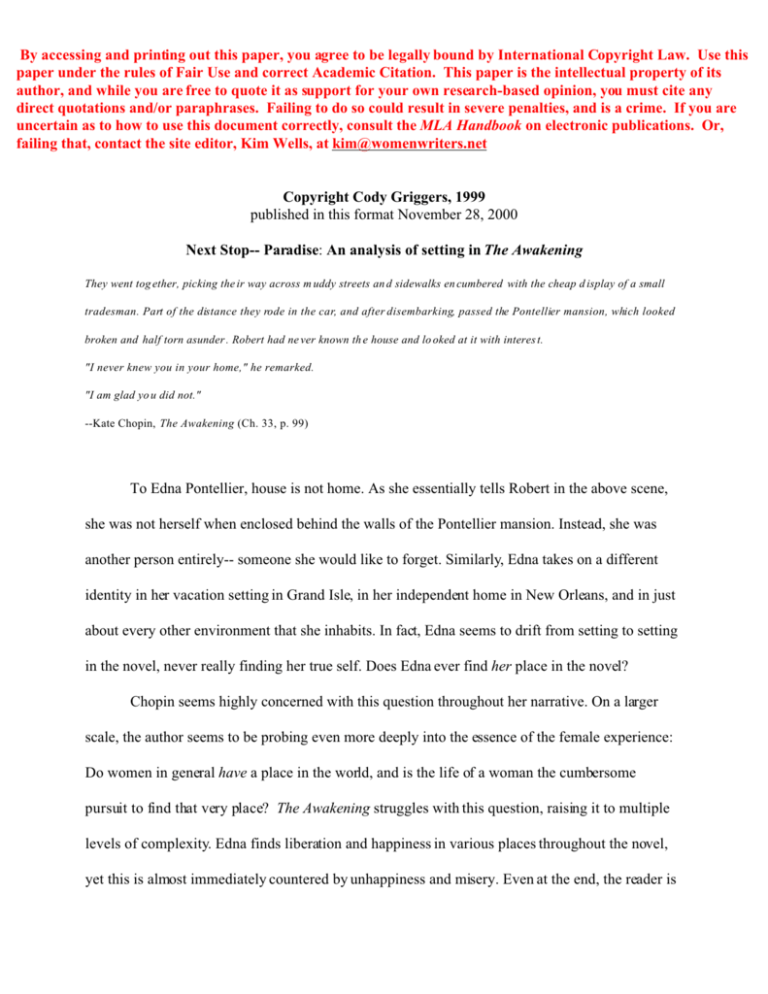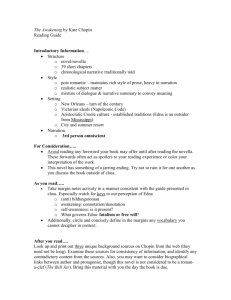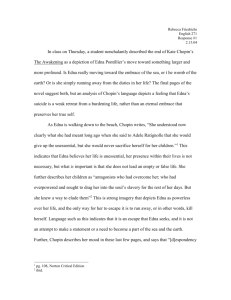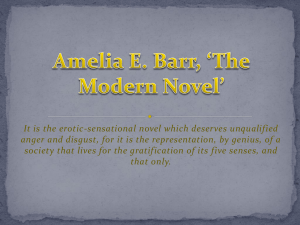Next Stop-- Paradise: An analysis of setting in The Awakening.
advertisement

By accessing and printing out this paper, you agree to be legally bound by International Copyright Law. Use this paper under the rules of Fair Use and correct Academic Citation. This paper is the intellectual property of its author, and while you are free to quote it as support for your own research-based opinion, you must cite any direct quotations and/or paraphrases. Failing to do so could result in severe penalties, and is a crime. If you are uncertain as to how to use this document correctly, consult the MLA Handbook on electronic publications. Or, failing that, contact the site editor, Kim Wells, at kim@womenwriters.net Copyright Cody Griggers, 1999 published in this format November 28, 2000 Next Stop-- Paradise: An analysis of setting in The Awakening They went tog ether, picking the ir way across m uddy streets an d sidewalks en cumbered with the cheap d isplay of a small tradesman. Part of the distance they rode in the car, and after disembarking, passed the Pontellier mansion, which looked broken and half torn asunder . Robert had ne ver known th e house and lo oked at it with interes t. "I never knew you in your home," he remarked. "I am glad yo u did not." --Kate Chopin, The Awakening (Ch. 33, p. 99) To Edna Pontellier, house is not home. As she essentially tells Robert in the above scene, she was not herself when enclosed behind the walls of the Pontellier mansion. Instead, she was another person entirely-- someone she would like to forget. Similarly, Edna takes on a different identity in her vacation setting in Grand Isle, in her independent home in New Orleans, and in just about every other environment that she inhabits. In fact, Edna seems to drift from setting to setting in the novel, never really finding her true self. Does Edna ever find her place in the novel? Chopin seems highly concerned with this question throughout her narrative. On a larger scale, the author seems to be probing even more deeply into the essence of the female experience: Do women in general have a place in the world, and is the life of a woman the cumbersome pursuit to find that very place? The Awakening struggles with this question, raising it to multiple levels of complexity. Edna finds liberation and happiness in various places throughout the novel, yet this is almost immediately countered by unhappiness and misery. Even at the end, the reader is Copyright Cody Griggers, 1999 published in this format November 28, 2000 http://www.womenwriters.net/domesticgoddess/pdf/griggers.pdf page 2 still left with the question of whether Edna has truly found a setting in which she can finally be herself. Many readers would argue that Edna finds this niche in her seaside vacation home on Grand Isle. To Edna, the sea is a wide expanse of opportunity and liberation from the constricting socialite world of French Quarter New Orleans. Chopin’s lavish descriptions of the sea give us an insight into its powerful effect on Edna: The voice of the sea is seductive; never ceasing, whispering, clamoring, murmuring, inviting the soul to wander for a spell in abysses of solitude; to lose itself in mazes of inward contemplation. The voice of the sea speaks to the soul. The touch of the sea is sensuous, enfolding the body in its soft, close embrace (Ch. 6, p. 13). As Chopin writes, the sea is the place where Edna can truly look within herself in order to find out what lies beneath her socially constructed façade. Whether she ever does find her true self is another question. It is difficult to define Edna’s “self” because it never seems to emerge at any point in the novel. Chopin presents us with Edna’s identity problems early on: Mrs. Pontellier was not a woman given to confidences, a characteristic hitherto contrary to her nature. Even as a child, she had lived her own small life all within herself. At a very early period she had apprehended instinctively the dual life-that outward existence which conforms, the inward life which questions (Ch. 7, p. 13). The novel’s abrupt and tragic ending (coincidentally on Grand Isle) puts an immediate halt to Edna’s pursuit to answer those very questions. She does begin to slowly uncover small snippets of her life’s true value in different settings throughout the novel and therefore begins to stake a claim Copyright Cody Griggers, 1999 published in this format November 28, 2000 http://www.womenwriters.net/domesticgoddess/pdf/griggers.pdf page 3 for an identity. For example, it is on Grand Isle that Edna learns to swim-- a moment of complete liberation and discovery of her self, or at least a some facet of identity: But that night she was like the little tottering, stumbling, clutching child, who all of a sudden realizes its powers, and walks for the first time alone, boldly and with over-confidence. She could have shouted for joy. She did shout for joy, as with a sweeping stroke or two she lifted her body to the surface of the water (Ch. 10, p.27). Chopin’s language in this passage is very telling of Edna’s life existence. Edna has always felt like a child, just waiting to unleash her capabilities. On Grand Isle, she finds that she can do that very thing. Edna is not gaining new powers; instead she is realizing them--implying that they were always latent within her. She needs only to be in the right environment in order to harness and express them. Grand Isle is also the setting for another moment of self-discovery and liberation for Edna. It is here that she meets Robert Lebrun--the one true love she has found in her life. Edna begins to find herself through Robert. She realizes through him that her husband is “a person whom she had married without love as an excuse” (Ch. 25 p. 77). It often seems that the seaside setting of the island--physically removing her from the scrutiny of her husband and the society that scorns her--is truly the only place where such a discovery can occur. Edna and Robert can walk on the beach as lovers in the darkness and not worry about what people will say. There is no societal gossip on Grand Isle--in fact, there often seems to be no society at all--providing an excellent backdrop for Edna to experiment in her romantic life, adding to the fruits of her soul-searching. Edna learns that she has a capacity to love on the island. Far away from her husband and the Copyright Cody Griggers, 1999 published in this format November 28, 2000 http://www.womenwriters.net/domesticgoddess/pdf/griggers.pdf page 4 constraints of maternal and matrimonial duty, she is able to remove the mask she has been wearing for so long in order to see what lies beneath. Surrounded by the wildness of nature, she seems to succumb and become a primal being-giving in to her deepest and most inward emotions. But Grand Isle, like the other settings in the novel, is thematically troubled. While on a spiritual level, the island seems to represent freedom and self-liberation for Edna, on a literal level, the island also symbolizes the same kind of entrapment that faces Edna. As an island, Grand Isle is surrounded on all sides by water and cut off from the mainland; Edna’s true self is surrounded on all sides by societal constraint and is completely cut off from the rest of the world around her--including even herself. Edna only needs to find that island of her true identity in order to see that, like the physical setting it represents, it too flourishes in its solitude. Islands often tend to be more beautiful and pristine because of the fact that they are isolated from the filth and degradation of the mainland environment. Thus, just as Edna goes to an island to escape from this, she finds within herself a special island that is herself--something that no one else has been able to discover or taint. For the first time, Edna is a close as she has ever been to a whole person, rather than existing as a mere dot on the mainland of society. This reading of the novel may seem a bit too naturalist, but we cannot ignore the changes that occur within Edna as she drifts from setting to physical setting throughout the course of Chopin’s text. When Edna finally must drift back to the other main setting in the novel, New Orleans, we find her a completely different person. The vacation at Grand Isle has indeed awakened latent passions within her soul, and it frightens Edna to have to bury them once again. Edna bids a sad farewell to the vacation home, as Chopin writes: “As their stay at Grand Isle drew to its close, she Copyright Cody Griggers, 1999 published in this format November 28, 2000 http://www.womenwriters.net/domesticgoddess/pdf/griggers.pdf page 5 felt that she could not give too much time to a diversion [swimming] which afforded her the only real pleasurable moments that she knew” (Ch. 16, p. 46). The four constraining walls of the Pontellier mansion in New Orleans quickly stifle all of these joys. Chopin immediately gives the reader a glimpse of just exactly how the house fits into the Pontellier relationship: Mr. Pontellier was very fond of walking about his house examining its various appointments and details, to see that nothing was amiss. He greatly valued his possessions, chiefly because they were his, and derived genuine pleasure from contemplating a painting, a statuette, a rare lace curtain-no matter what-after he had bought it and placed it among his household gods (Ch. 17, p. 50). Clearly, we can see that the Pontellier mansion is just that--Mr. Pontellier’s home. Edna makes this clear to us when she tells Mademoiselle Reisz that she is “tired looking after that big house. It never seemed like mine anyway” (Ch. 26, p. 79). This is not Edna’s home. Instead, Edna serves Mr. Pontellier just like those fine lace curtains and rare statuettes--she is an ornament. Her husband has provided for her very well financially and they live in a paradigmatic home--but because of this, Edna must do her part and be the model wife for that model home. This becomes the source of Edna’s unhappiness-having to fulfill a “rôle” that does not do justice to her inner desires. She must field endless streams of callers every Tuesday, make flashy public appearances on the arm of her husband at operas and galas, and must entertain dinner guests on a regular basis. As Pontellier explains to his wife, “We must observe les convenances if we are to get on and keep up with the procession” (Ch. 7, p. 51). This is where the internal conflict lies: Mr. Pontellier wants to keep up with the procession of society and Edna wants to drop out of the parade and walk to the Copyright Cody Griggers, 1999 published in this format November 28, 2000 http://www.womenwriters.net/domesticgoddess/pdf/griggers.pdf page 6 beat of her own drum. It is interesting to consider, therefore, that amidst the “convenances” of New Orleans society, Edna actually does find some moments of liberation. It is in the city that Edna learns to walk. Much like a child taking its first steps, Edna begins to walk alone on the streets of New Orleans and her eyes are opened to a world that she never knew existed-a world within herself: There were days when she was very happy without knowing why. She was happy to be alive and breathing, when her whole being seemed to be one with the sunlight, the color, the odors, the luxuriant warmth of some perfect Southern day. She liked then to wander alone into strange and unfamiliar places. She discovered many a sunny, sleepy corner, fashioned to dream in. And she found it good to dream and to be alone and unmolested (Ch. 19, p. 58). Even in New Orleans, Edna finds a niche--on the streets, away from the constrains of the mansion. Just like on the beach, Edna absorbs herself in the solitude of nature, allowing her inner soul to ripen like a fruit on the vine in the sunshine. Edna’s entire happiness seems to hinge on being in the outdoors, in the openness of the natural world. Her two most liberating activities, swimming and walking, both occur outdoors and they each bring her to a heightened level of understanding of herself. Even when Edna finally gets a home of her own and claims “I know I shall like it, like the feeling of freedom and independence,” the reality falls short of her expectations (Ch. 26, p. 80). Not only does Edna want solitude, she also wants freedom from the entrapment of any home. Aptly nicknamed “the pigeon house,” Edna’s new home is no less of a cage than any other that she has been inside. Edna can, therefore, be read as a wild animal that society has caged for far too long and Copyright Cody Griggers, 1999 published in this format November 28, 2000 http://www.womenwriters.net/domesticgoddess/pdf/griggers.pdf page 7 who finally wants to escape into the natural world. Chopin actually puts these words right into Edna’s mouth. As she ponders Alobin, she realizes that he “appeals to the animalism that stirred impatiently within her” (Ch. 26, p. 78). On the most basic level, this is what Chopin’s use of setting brings out the most in her character. We pity Edna in the same way we would pity a hawk kept in a birdcage. In order to realize its full potential, the hawk must spread its wings and see the world that it was created to see. Edna must do the same, and succeeds on some levels. Even in the end, when Edna plunges herself into the sea, at the mercy of nature, she experiences the power of the natural world in a way that only she could truly appreciate. Chopin puts it best when she writes, “The bird that would soar above the level plain of tradition and prejudice must have strong wings. It is a sad spectacle to see the weakling bruised, exhausted, fluttering back to earth” (Ch. 27, p. 83). Edna dies in the end, but the one thing she does not do is fall back to the earth. Instead, she finally spreads those wings and soars up into a well-earned paradise.






